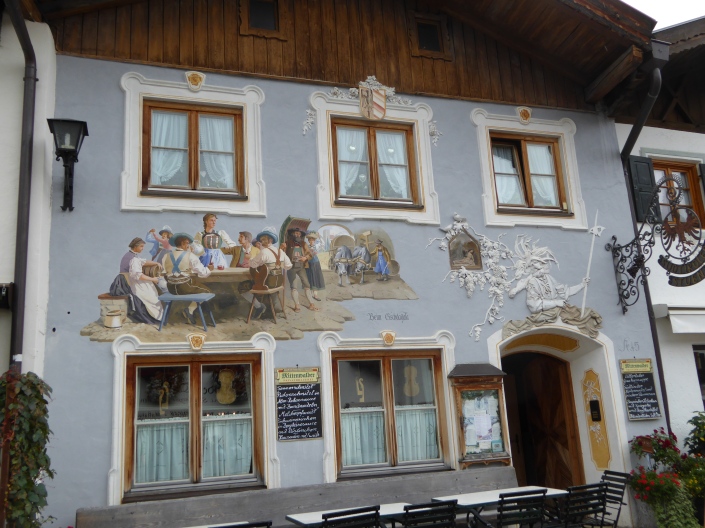An other miracle in Bavaria: the Facade painting
Traditional Bavarian frescoes (artistic facade painting or open air art ) are dotted all over Alpenwelt Karlwendel. Nowhere else in Upper Bavaria will you see so many frescoes dating from the 18th Century as in Mittenwald, Krün and Wallgau. Today, artists still turn facades into “lively picture books”, as J. W. Goethe, the great German poet called them. The themes, fairy tales, religious scenes or architectural trompe-l’œils found on many homes and buildings.
Lüftlmalerei or trompe-l’œils
Outdoor mural, or fresco’s -Lüftlmalerei in German, or trompe l’oeil in French-technic originates in the Baroque period, when it refers to perspectival illusionism. But trompe-l’œil dates much further back. It was (and is) often employed in murals. Instances from Greek and Roman times are known, for instance in Pompeii. How can I explain: a typical trompe-l’œil mural might depict a window, door, or hallway, intended to suggest a larger room. A version of an oft-told ancient Greek story concerns a contest between two renowned painters. Zeuxis (born around 464 BC) produced a still life painting so convincing that birds flew down to peck at the painted grapes. A rival, Parrhausis, asked Zeuxis to judge one of his paintings that was behind a pair of tattered curtains in his study. Parrhasius asked Zeuxis to pull back the curtains, but when Zeuxis tried, he could not, as the curtains were included in Parrhasius’s painting—making Parrhasius the winner.
Later on the art of painting frescoes became a folk-based variation of the Baroque trompe l’œil phenomenon. The images are painted onto the fresh lime render on the house wall using fresco techniques. In a chemical reaction, the colors “silicify” with the plaster, which makes the pictures waterproof and durable.
Bavaria and Tirol, specially Oberammergau, Mittenwald are all famous for their “Lüftlmalerei-s (the name Lüftlmalerei may be derived from an Oberammergau house, called Zum Lüftl, which was the home of a facade painter, Franz Seraph Zwinck (1748–1792). In the past in some villages it’s traditional to hire-a facade painter to decorate the front mural of the house. They tell stories of traditional life and the deeply rooted beliefs of the inhabitants: Woodworkers and raftsmen go about their hard labours, St. Christopher carries the Baby Jesus over the river and a great celebration is underway in a merry inn scene.
In Mittenwald in the Werdenfelser region at the foot of the Karlwendel you will notice immediately that pictures adorn the walls of the old houses. The colorful works often tell stories from the Bible, such as of The Resurrection and The Agony in the Garden, or depict fires and floods but also popular the Sun-dial theme.
And also in the neighboring villages, many paintings have endured to this day, a lot of them are more facade art. For instance the facade of the Hotel Rheinischer Hof in Garmisch-Partenkirchen, in which two mountaineers from different eras are climbing a mountain together. “Traditional fresco painting used mineral pigments and tended to represent rural and religious scenes, as was common in the 18th century”.
Mural paintings also in Switzerland
Stein am Rhein (at Constance lake) is widely regarded as Switzerland’s best preserved medieval small town. The immense cultural heritage of this city is a major source of pride to the citizens of Stein am Rhein. As children, they learn about the colorful stories told by the painted facades of historic buildings. These paintings, some biblical or historical in nature depict tales of wine, vineyards, crafts, festivals and a full range of human conditions. Themes vary from history or mythology, commerce or warfare to morality. Originally, the wealthy residents of these decidedly upscale dwellings had these frescoes applied as highly visible testimony to their affluence. These wonderfully frescoed buildings are windows that offer an amazing clarity on The Middle Ages. Go and see how vibrant the colors still are even after more than 200 years!
